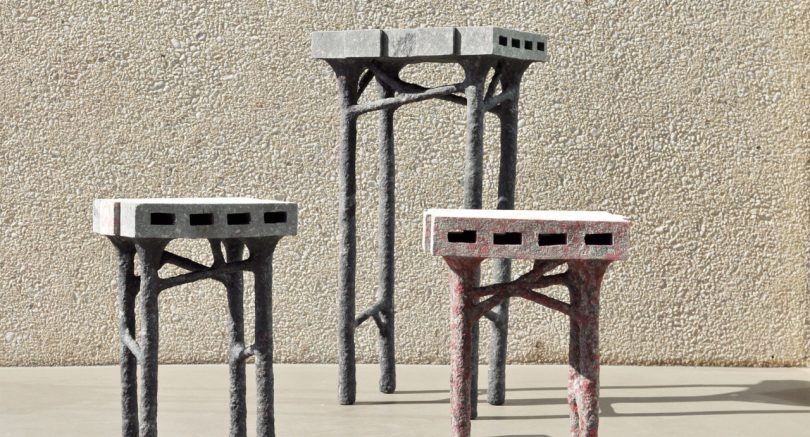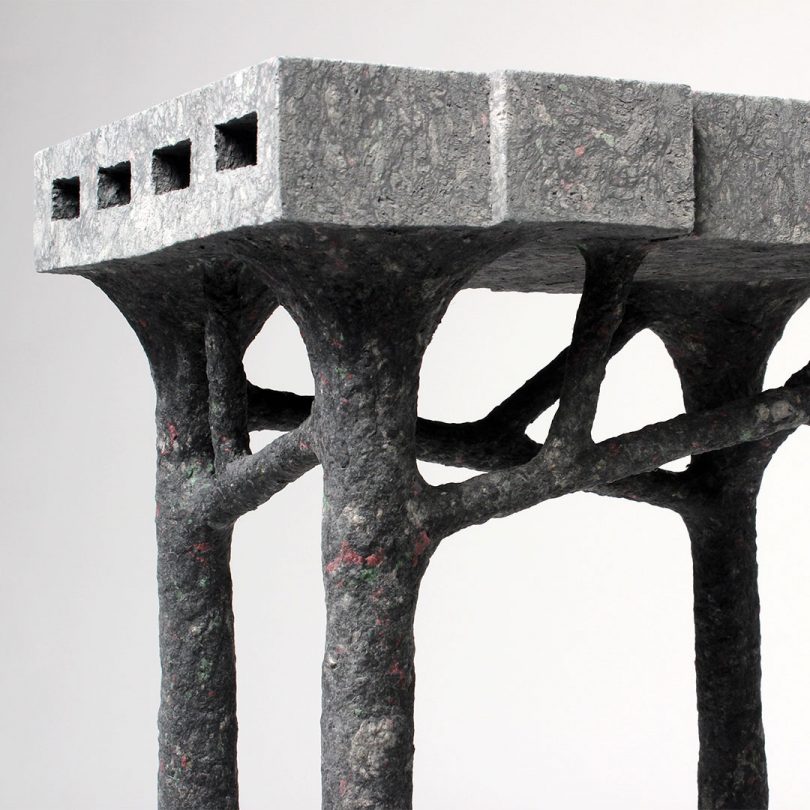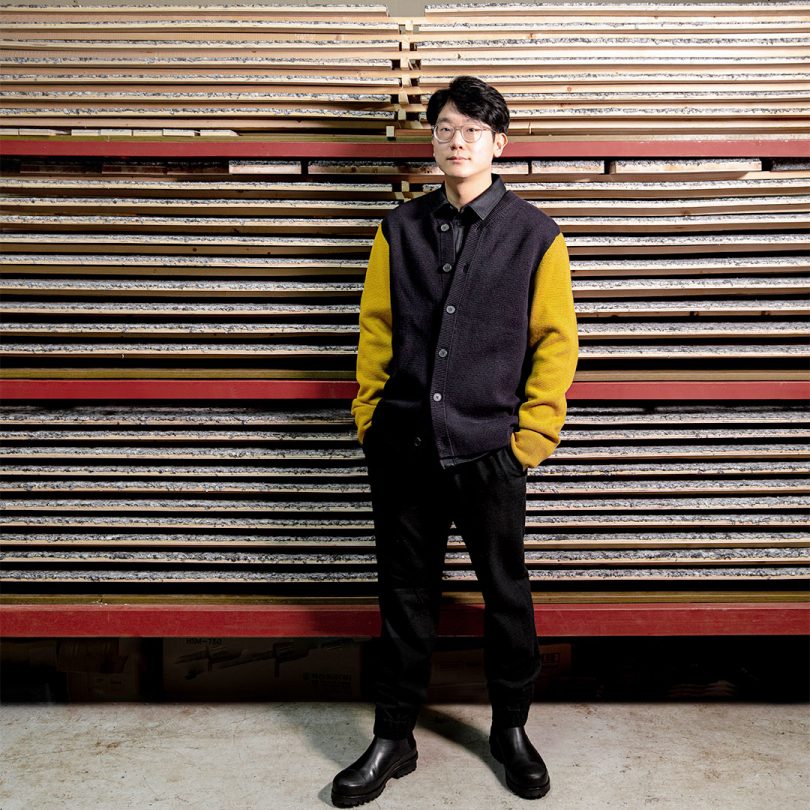The circular economy is a proposed alternative to our traditional ‘take, make, waste’ model of production and consumption – one that offers hope in the face of environmental catastrophes from climate change to ocean plastic. Designing out waste and pollution, keeping materials and products in use and regenerating our natural environment are so important to contemporary design that we wanted to create a dedicated space for the projects bringing these ideas to life. Circular by Design, a new weekly column by longtime contributor Katie Treggiden, will start by exploring the potential of waste as a valuable new raw material.
Eindhoven-based Studio Woojai is run by Korean New Zealander WooJai Lee, a designer motivated by exploring and experimenting with the hidden potential of sometimes surprising materials. We caught up about one project in particular that repurposes waste paper into functional bricks and sculptural furniture.
Tell me a little bit about your childhood, education, and background in terms of how you first became interested in creativity, design, and sustainability.
I was born in Korea and moved with my family to New Zealand when I was 10 years old. Growing up in New Zealand, I was exposed to the greenery and nature all around me. I wasn’t particularly interested or fond of nature as a child, but I guess it influenced me unknowingly. I still find the characteristics and forms of nature very interesting in my design language. Both my parents are from creative backgrounds, so following a creative path seemed quite natural as well. I moved to The Netherlands and studied at Design Academy Eindhoven, graduating with a Bachelors degree in 2016 with my project ‘PaperBricks‘. I have been practicing in my own design studio in Eindhoven ever since. I am also part of Collaboration O, a collective of young designers in Eindhoven. We share a workspace and also collaborate on various projects and exhibitions together.
How would you describe your Paper Bricks, Paper Bricks Sculpt Series, and Paper Bricks Pallet Series?
PaperBricks are made from recycled newspapers. They are very strong and have the stone-like marbling aesthetic of a construction material, and at the same time as having the warmth and soft tactility of the paper. The PaperBricks Pallet Series was created using PaperBricks to show how they can be used constructively. With the PaperBricks Sculpt series, I also wanted to explore the contrasting characteristics of a material. Paper can be both soft and hard, rough and smooth, systematic and irregular, all of which can be seen in this series – the soft surfaces, rigid shapes in contrast to rough and natural forms. The contrast is also in the way of working. The mold manufactured bricks to freely sculpted legs.
What inspired this project?
One day I was taking out my rubbish for recycling and noticed a big pile of paper. Most of the paper was newspapers and advertisements, which we only glance for a few minutes and throw away. I felt pity for this material, which seemed to have such a short life span. Through research, I also found out that paper is one of the most recycled materials, but every time it is recycled, it is down-graded until eventually, it cannot be recycled anymore. I wanted to give this material a new life. A life in which it can be much stronger and used for different purposes, other than the fragile and short life it usually has.
What are they made from, how did you select that particular material, and how do you source it?
In the process of printing newspapers, there are always lots of newspapers which are being misprinted or overprinted. I use these newspapers to create my works.
When did you first become interested in using waste as raw material and what motivated this decision?
As a design or art student, you are constantly faced with the twin dilemmas of using new materials (the cost of which can also be a problem) and producing ‘waste’. I always tried to find different ways to re-use and source materials which are considered ‘waste’ or leftovers from previous projects. Soon, these ‘wastes’ became ‘treasures’ for me to work with.
What processes does the material have to undergo to become the finished product?
The newspapers are first soaked in water and made into a pulp. Then they are mixed with adhesive to create a mixture which is shaped into a mold to form bricks. The PaperBricks are dried and treated for the final form.
What happens to your products at the end of their lives? Can they go back into the circular economy?
To be completely honest, I have not yet seen the end of their lives to give you a definite answer. However, from my experience with samples, they could be turned back into pulp, which could be used again to make other accessories or back into PaperBricks.
How did you feel the first time you saw the transformation from waste material to product/prototype?
It was very surprising to see the strength of the outcome and also how, at the same time, it was smooth and soft in its tactility. I really liked how it held the contrasting characteristics together in one outcome.
How have people reacted to this project?
I really enjoy people’s reaction when I tell them that it is made out of paper. Without any explanation, they tend to mistake it for marble or other mineral material. When they touch it and feel the soft and warm tactility of the bricks, they start to get curious about its true material and are always surprised when I tell them its made out of paper. I would like to see how this project can inspire others to think differently of a material which we are so familiar with. A material which is very much integrated into our lives, such as paper, can also have different potentials if we can just pay a little more attention.
How do you feel opinions towards waste as a raw material are changing?
With the current COVID-19 situation and through the absence of human activity, our negative impact on the natural environment became much more visible. Re-used waste materials have been praised as a concept for a long time, but real belief and trust in them has seemed rather minimal. I think the current situation could really push people to take much more sustainable choices.
What do you think the future holds for waste as a raw material?
As resources become ever more scarce, and our attention to the environment becomes greater, I believe the demand and attention to waste as raw material will continue to grow. Designers and artists are not scientists or engineers but, as creatives, we can always suggest concepts and ideas which look at things from outside the box, showing the hidden potentials of different materials, breaking down stereotypes around a particular material, and giving positive images for new directions.
from WordPress https://connorrenwickblog.wordpress.com/2020/06/09/circular-by-design-studio-woojai-turns-waste-paper-into-bricks-and-furniture/














No comments:
Post a Comment